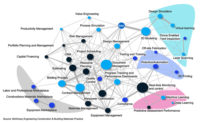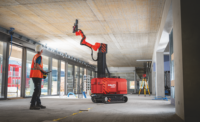FutureTech 2020 Day Four: Looking Forward to Better Automation
As construction retools in the pandemic, digitization continues in supply-chain management and on jobsites

Dusty Robotics little autonomous robot can print layout markings directly onto the floor slab using data from the BIM and a nearby total station.
Video Screenshot Courtesy of Dusty Robotics

A survey by Dodge Data & Analytics found that MEP contractors may be passing a tipping point on BIM usage.
Graphic Courtesy of Dodge Data & Analytics

Dodge analysts drilled down further into their survey data, and found signs that mechanical contractors were using BIM for prefabrication work.
Graphic Courtesy of Dodge Data & Analytics

The OMega system is an in-house tool used by McKinstry to automate the handoff between digital design documents and supply chain orders.
Image Courtesy of McKinstry

Brasfield & Gorrie has been trialing a Boston Dynamics Spot robot dog with 360° cameras in concert with overhead scans from DroneDeploy, for comprehensive visual documentation of jobsites.
Video Screenshot Courtesy of Brasfield & Gorrie

Black & Veatch ran trials of an autonomous excavator on a greenfield solar project. Results were promising, and the company plans to bring the technology from Built Robotics to other projects.
Video Screenshot Courtesy of Black & Veatch






Sessions from ENR FutureTech 2020 are now available for on-demand streaming
As ENR FutureTech 2020 rolled into its fourth and final day, presentations offered a sense of emerging construction technologies and what comes next for developers and users amid a pandemic hit marketplace.
Steve Jones, senior director of Dodge Data & Analytics, said that despite a significant decline in office and retail construction, there are bright spots for some non-residential market sectors, including healthcare and warehouses for e-commerce fulfillment.
There are also hints of a shift toward renovation over new construction, which he described as a sign the construction economy is slowing. “We are in a cyclical business. This is just what it does,” said Jones.
But Dodge analysis also found real acceleration in technology adoption among industry companies, even before the onset of the COVID-19 pandemic. More specialty contractors are using BIM, moving away from their traditional methods of doing quantity takeoffs and 2D shop drawings. “They’re exporting data from models to the field … everybody is doing it,” said Jones. “It’s very much becoming standard practice.”
Specialty contractors discussed impacts of their increased digitization. McKinstry, which offers comprehensive design-build-operate-maintain services, can take advantage of digitizing orders directly from the specifications in design files, said C.J. Best, its director of manufacturing. “We were able to automate the ability to put in material requests,” he told attendees.
McKinstry's in-house-developed ordering system, OMega, is modeled on an online shopping cart interface that has greatly sped up MEP work as staff in the shops are able to order directly the model’s specifications, according to Best.
“Our VDC exports the sub assemblies, so for mechanical piping those are spool sheets,” he explained. "Whoever is in the shop can grab whatever assemblies they want and create an order. We’re no longer constrained by ordering just parts of the package—the shop can make any adjustments.”
Real-World Uses For Autonomous Equipment
The digital transformation of construction can also be seen in the steady growth of robotics. Full automation of construction tasks has found its way to more jobsites, with promising results. Black & Veatch ran a pilot of Built Robotics’ fully autonomous hydraulic excavators on a solar energy project in Nassau County, Fla., near Jacksonville, which tested the potential of robotics against construction's tough environment.
Tyler Parker, the firm's business optimization manager for global renewable energy, and Gaurav Kikani, vice president of Built Robotics, showed how the latter's autonomous excavator and other robotic earthmovers are helping deliver solar projects.
“The ways we move dirt and do the construction side of things are largely the same as they were 50 years ago,” Parker said, noting that most use of digital tools so far has been in design and project management. He said solar energy work was a good place to try out Built Robotics’ sensor-laden, software-supervised equipment—overseen by someone with a new job title, robotic equipment operator.
In the long-term, Parker said, the right people to run robotic equipment are operators who understand the mechanics of sophisticated pieces of equipment such as excavators.
Safety was a key provision that allowed Black & Veatch to gain buy-in from field workers on solar projects. Having fewer employees near the trench in which the fully autonomous Built excavator is digging, reduces risk. Built's automation system is designed to be retrofitted onto existing heavy equipment, greatly simplifying maintenance and operation.
Site staff "were happy to get the excavator on site and everybody was happy with it,” Kikani said. “The real value, was feedback that we got on how to improve the integration for the future.”
Parker noted that with difficulty in attracting young operators into the craft, a new job category such as robotic equipment operator could be the draw Black & Veatch needs. “We absolutely need younger people to have an interest in construction,” he said, adding that the industry also needs the expertise of veteran workers "to know what to do when something goes wrong. We need both.”
For Kikani, the earthmoving equipment Built has already automated is just the start of a broader effort to bring robotic processes onto jobsites.
“Excavators are the core of our fleet and our technology today, but there’s more we can do,” he said. "Unless our robots can deliver consistent commercial value, it’s just a science experiment. The potential is there and demonstrating that will keep us tracking right.”
Linking the Model to the Site
FutureTech panelists also shed light on how firms are pushing the limits of robots and drones on site. Ryan Hittie of Brasfield & Gorrie noted results of the contractor's recently announced partnerships with robot manufacturer Boston Dynamics and UAV surveying firm DroneDeploy.
Hittie piled 360° cameras and sensors onto Boston Dynamics’ Spot robot dog to document interiors of a building site, while also flying DroneDeploy’s drones over the same site. These two data sets were then combined in a version of the project’s 3D model, creating a comprehensive visual inspection that covered every part of the site. It provided a useful reality capture of the job and removed risks associated when multiple staff regularly walk the site with 360° cameras.
“We aren’t in danger of being replaced by robots. We are replacing the danger, making it safer,” said Hittie.
Automating site documentation is one thing, but what if a robot could print the exact model dimensions onto the site, removing any chance of human error during layout?
That was the core of the presentation by Frank Haase, vice president of Suffolk and Tessa Lau, CEO of Dusty Robotics.
"Bringing even most complex project designed in BIM—with all the work that goes into creating those models—to the field is still a very manual process,” explained Lau. Dusty Robotics' little wheeled robot can print layout marks directly onto the floor slab with 1/16th-in. of accuracy, taking its position from a nearby total station. Every installation, from wall segments to specific MEP elements, can be marked out, taken directly from the model.
But the robot is only as smart as the data loaded into it, and not all BIMs are created equal.
A densely modeled structure, with MEP and finishes also loaded in for clash detection before the project even starts, is the key to better automating the layout and construction process, said Haase.
“The standard process [in the industry] is to take 80% finished drawings and hand them off to trades to do their own thing,” he said. “But that just leads to different models and you get the RFIs coming in.”
Better automation of these handoffs could also help the industry better cope with the knowledge drain that accompanies a rise in worker retirements.
"Layout is one of the highest skilled, highest value tasks—some of the most skilled forepersons are doing layout,” said Lau. With more specialized knowledge on how to do it correctly, "robots are helping to solve that labor-shortage problem.”











